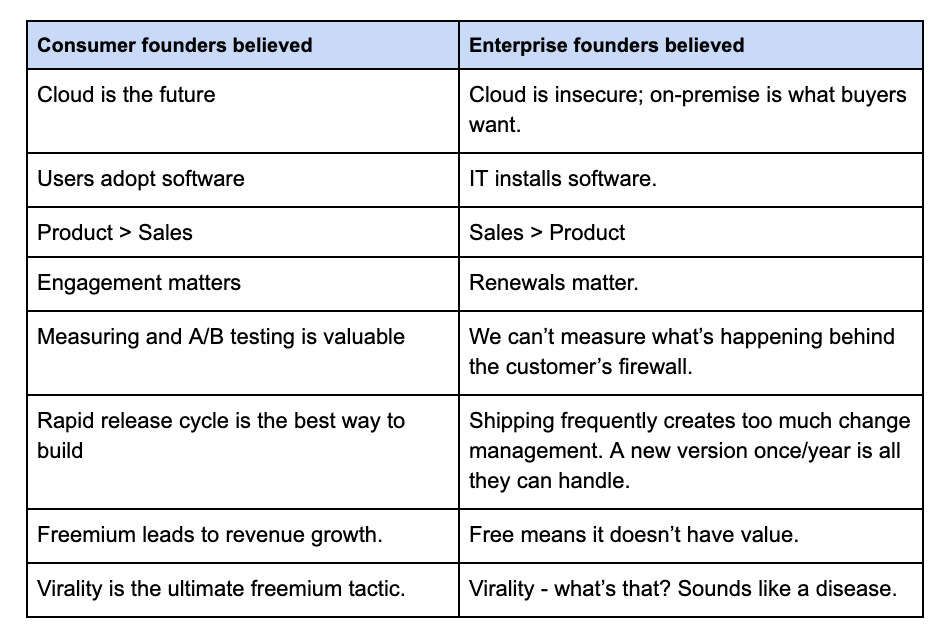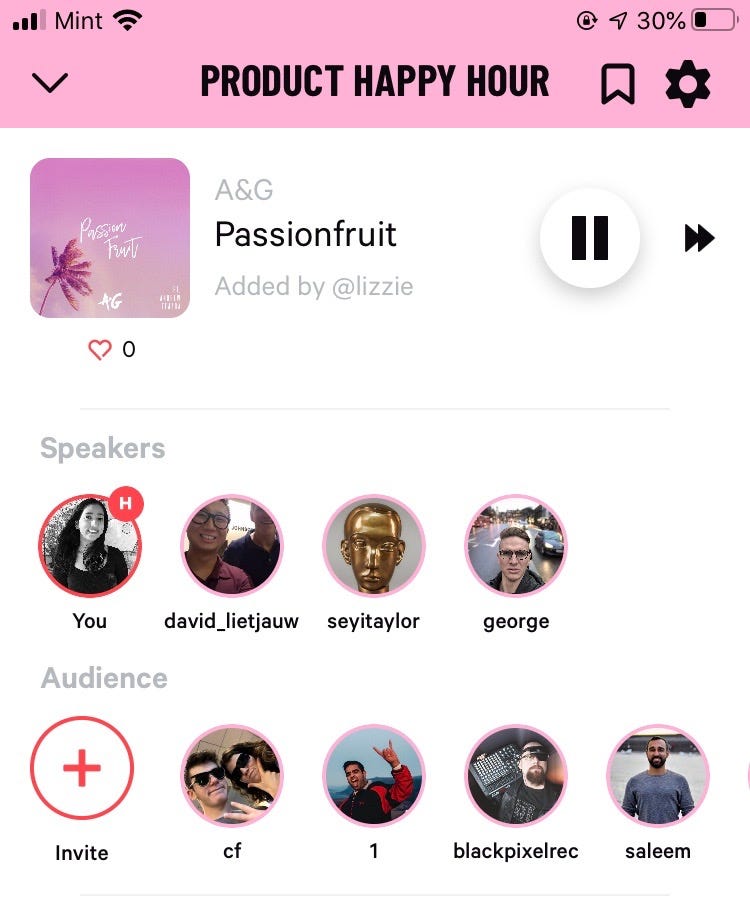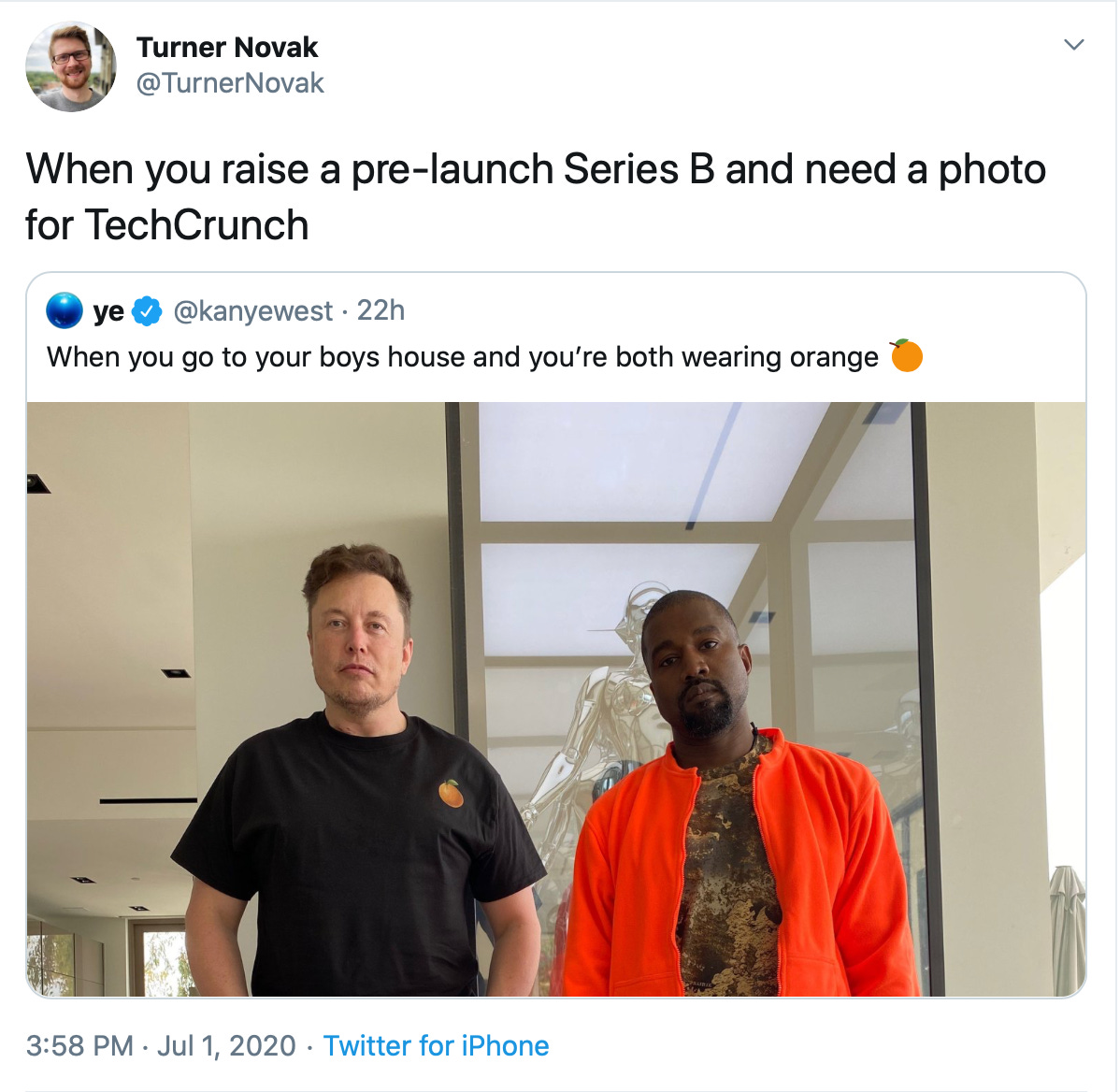Stealing Signs - Issue 33
The Bottom-Up Playbook, Worldconnectors, Roadtrip = the Local Bar, Marketing is Eating the World, & Runway Financial
Worth Reading
David Sacks & The Bottom-Up Playbook
Brianne Kimmel, Work Life Ventures
A decade ago there was a really sharp divide between consumer and enterprise, these spaces were highly compartmentalized. We brought a lot of consumer thinking and consumer tactics to enterprise...Gradually over the last decade or so, the barriers have really come down, to the point where I think most founders see this consumerized approach as probably the best way to develop enterprise software.

The consumerization of enterprise is a well-established phenomenon nowadays, but this is fascinating breakdown from the entrepreneur (now investor) who pioneered it, David Sacks.
While reading this piece I arrived at what may be an obvious insight to many (certainly David), but it was helpful for me in understanding how enterprise is consumerized — the enterprise employee experiences many of the same challenges that the average consumer does. Many of the same gaps in user experience exist in the consumer and enterprise settings, and thinking about the employee as an individual consumer rather than a cog in a machine is an effective framework to understand their needs, even ones they don’t yet know they have. An example of a challenge experienced by both enterprise employees and consumers is knowledge organization and sharing. In the consumer realm, companies like Roam Research and Notion are attacking this problem and have blossomed in doing so. Consumers need a better way to document knowledge and many desire a way to share it publicly.
On the enterprise side, the Google and Microsoft suites come to mind. Enterprise employees have the same problem as consumers — how do they 1. document their knowledge and 2. do so in a way that's sharable and discoverable by others? This is where the employee = consumer framework is helpful, vs. the enterprise/consumer comparison. The latter comparison introduces a clear difference in use cases — of course enterprises have different needs than consumers. The former comparison, though, between enterprise employees and consumers, surfaces a more similar problem set.
Worldconnectors & The New Mainstream
Marc Geffen, Head of Strategy at Pulsar
Worldconnectors don’t necessarily set out to build. They set out to think, to create art or synthesize information, to infect others with ideas and feelings. They are highly generative and prolific. But their power is not a matter of top-down impact; they don’t make things go viral at will. Worldconnectors are experts at setting the conditions for organic virality.
Studying Worldconnectors can help shake us free from the lazy assumption that follower counts and impressions = influence. We like these metrics because they are a short cut, an abstraction from the living, breathing, sometimes very messy network that underlies any system where people are involved. But — as the Worldconnector shows us — we’re glazing over a lot of sociological and mathematical meaning by being so obsessed with pure reach.

The Worldconnector is a new archetype for leadership and entrepreneurship. The key attributes of this archetype include membership to many different groups and the ability to cross-pollinate, defining the conditions for organic vitality, and consistently great timing. The Worldconnector is interesting to consider in the context of the rapidly emerging creator economy — people leveraging social platforms and new technology tools to build a following and create content or services, and usually in that order. When looking at examples of world connectors identified in this piece like John Mayer, Action Bronson, and Megan Rapinoe, it’s clear their large sphere of influence plays a critical role in their ability to define conditions for vitality and cross-pollinate across many different groups. Other examples I came up with include Jay-Z, Kevin Durant and Andre Iguodala, Serena Williams, and Kanye. These folks are superstars with massive followings and the freedom to venture down a variety of paths. What’s less clear, though, is how someone becomes a world connector without being a superstar athlete or world-famous artist.
I’ve written a lot about the emergence of business writing on the internet, namely the flurry of new, awesome Substack writers, and I think this trend provides a path to a new wave of worldconnectors that aren’t necessarily athletes and artists by creating their own, new worlds to connect. Substack writers like Packy McCormick, Lenny Rachitsky, Nathan Baschez, and Li Jin are creating new worlds centered around their content. Their connection through membership to the Substack community and overlapping Twitter groups enables them to cross-pollinate their ideas and analysis across many different groups, from NBA stars like Chris Bosh to S-1 breakdowns like The Generalist newsletter. They can also define trends and conditions for organic virality, much like the superstar athlete and artist worldconnectors, by creating content and encouraging engagement with emerging social themes and technology products, cementing them in the mainstream.
People, Pivots, & Product
Anisha Sunkerneni, Web Developer
Among other more unique use cases discussed were using Roadtrip for group or partner workout sessions, meetings, and professional presentations within private rooms. Re: Roadtrip for workouts, one member added:
That would be great. The thing with music is it drowns out the silence, so you can just carry on. You don’t have to unnecessarily speak when you don’t need to. You can just work out, you know? And keep the call going when you have your rest breaks between sets.

Anisha gives us a very promising use case for the exciting new audio-first product, Roadtrip. She tells the story of Kevin Yien’s experience using Roadtrip as a Product Lead at Square to create a more welcoming environment for real-time group document analysis. Typically, Kevin’s team joins a Zoom meeting to read a document on previous work and future plans. He notes the presence of “painfully awkward dead silence” while everyone is reading, which creates a sub-optimal environment for sharing feedback. Roadtrip solves this problem. The music fills the void. No more awkward silence — Kevin suggests it “adds a special texture effect to the reading.”
After using Roadtrip for a few weeks I can definitely picture this use case, but I think it has even higher potential. An alternative outcome for Roadtrip is replacing Twitter as the local bar. The most exciting observation from users after weeks using the product is the amount of time spent in the app — some users spend hours a day in Roadtrip, jamming and conversing with others as they float in and out of rooms throughout the day. This is distinctly different from Twitter usage where users check the app every few hours (read: seconds), spend a few minutes scrolling through the timeline, and engage periodically as convos evolve. It’s asynchronous.
Roadtrip usage, on the other hand, is synchronous interaction between users. This can only happen if users are in the app for long periods at the same time. The music component of Roadtrip makes it easy to for users to do this — it siphons the hours spent passively listening to music Spotify. The audio-first nature of user interaction is also key here — it’s a more natural, authentic method of communication and allows room for spontaneity.
Music listening and vocal communication make Roadtrip a better candidate for the town hall or local bar that Twitter has been for so many years. While I stan Twitter, audio-first social platforms are pushing it more towards the bulletin board than the local bar. Audio-first platforms will take over as the primary method of frequent, spontaneous interaction between people.
Marketing is Eating the World
Elizabeth Yin, Hustle Fund
the US software industry, for the most part, is no longer about technology. If you are highly technical, and you want to win on product and tech, your best bet is likely in building a business that is not strictly software in the US OR in building a software business for an international market. But if you want to win in the US software market, ironically, the best thing you can for your company is to really ramp up your performance marketing knowledge. Marketing is eating the world.
Marketing is eating the world! Elizabeth makes a compelling case that the low hanging fruit in the U.S. software market is gone and to build a successful software startup today, one must focus on marketing. The software market is saturated which means distribution is more important than ever — in other words marketing is eating the world because distribution is king.
Marketing has long been a focus of consumer businesses. Borrowing from Charles Hudson’s recent interview on Venture Stories with Erik Torenberg, “In consumer my big question is what are you going to do other than spend money on ads.” In software more broadly, though, Elizabeth’s observation that marketing is eating the world is insightful. It seems obvious in hindsight, but it’s certainly not the way I hear other investors of founders talk about the dynamics of software businesses today. It does, though, align with the notion that CAC is the new rent. In other words, spend on customer acquisition for software businesses is as critical as spend on rent was for brick and mortar businesses of the past. If the marketing function is eating the world, then the CAC metric is eating the world alongside it.
<stuff> Weekly
LOL Weekly: A Photo for TechCrunch
lololololol

Funding Weekly: Runway
The CFO’s office spends so much time closing the books, nagging business unit leaders to fill out resource planning spreadsheets, and manually creating reports that they hardly have the time to be the strategic partner the CEO needs. And those in the company that are empowered to manage spend don’t have access to the data.
Runway raised a $4.5M Seed Round led by Andreessen Horowitz including Lightspeed, Naval Ravikant, Elad Gil, Niv Dror (Shrug Capital), Dylan Field (CEO of Figma), Henry Ward (CEO of Carta), Lenny Rachitsky, Erik Torenberg (Village Global), and Brianne Kimmel (Work Life VC).
The tweets below from Runway co-founder Siqi Chen sum up why I’m excited about this company:




Baseball Weekly: It’s Back
:))))))))))))))))))))))))))))))))))))))))))))
Art Weekly: Untitled
Felipe Oyarzún




